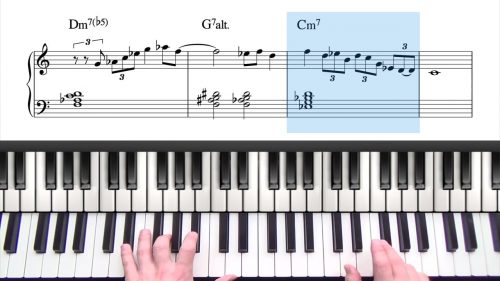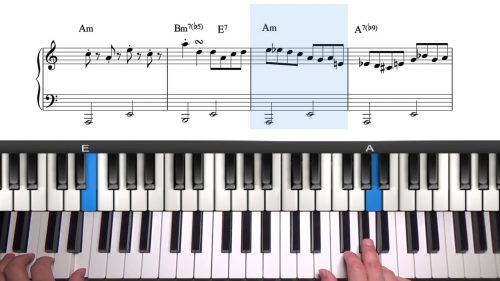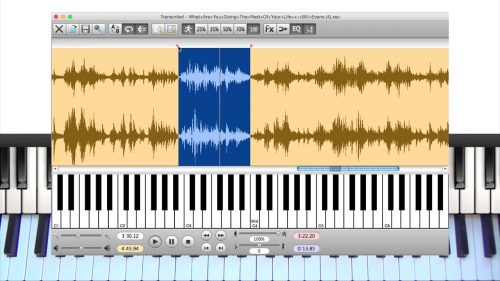Passing Tones & Chromaticism Tutorial
By now you should have a good understanding of the essential ingredients of an improvised line. Well now we are going to take it further with non diatonic passing tones and chromaticism.
This is where you can get creative and you will understand that there are no wrong notes. A non-diatonic tone, is a tone that is outside of the scale of the chord you are playing.
So for example, Bb7 takes the Bb Mixolydian scale, and the non diatonic tones would be the b9, #9, #11, #5 and maj7.
If we play these tones over the chord, you can hear they clash and that they are dissonant.
But that doesn’t mean that you can’t play them. In fact the opposite is true. You can play them but with caution, and make sure you are resolving back into the more consonant sounding chord tones.
Think of the chord tones as a safe place. And think of these non diatonic tones as very interesting places that you can go and visit, but just temporarily to add a bit of spice and interest to your lines.
Chromatic Runs & Target Tones
You can take non-diatonic improvisation a step further by using the chromatic scale. I’ve mentioned before that chromaticism is your best friend and it can get you out of some tight spots whilst improvising.
So that’s the end of lessons on chord tone soloing, approach patterns and passing tones. In the next lessons in the blues series we are going to introduce the blues scale — both the minor and the major blues scales — and then we’ll also explore blues licks and riffs. This is where things get real bluesy and funky to add that extra dimension to your solos.
Lesson Downloads
-
12 Bar Blues Lesson Supplement File Type: pdf
-
“Straight No Chaser” – Jazz Blues Form File Type: pdf
Practice Tips
-
There is list of F Blues records from a various different artists in the forum.
-
Check out the link below to the transcriptions threads. They are rated by difficulty so start with the easiest if transcription is new to you.
- If you listen carefully, you will hear most of the examples used in this series of lesson are in the solos of those recordings.






hello Hayden, I am learning so very much and join your efforts to provide an excellent path to learning the complex, circular, beautiful, daunting and fun world of Jazz. You are perfect and progressing openly. Thank you. I am computer challenged (need more teens around to show me the tricks) and work to follow to where I want to go. I am studying the Jazz Blues improv etc., you refer to a Blues thread and transcription thread that you took the time to organize into simple to more complex order., I get lost finding it. Have discovered the wonderful forum tho. Can you lead me to the place where you did post the above threads, perhaps by date for I need / want so tp listen. thank you for your time,,,,
now where do I go to find the answer????? hmmmm
Hey Cheryl 👋
Sure thing, here is the Transcription thread in the PianoGroove Forum:
https://www.pianogroove.com/community/t/transcription-exercises/147/9
That should take you straight to the blues transcription exercise.
If I can help you with anything else let me know 🙂
Cheers, Hayden
Hello Hayden. Nice video.
I would like to ask you what is the difference of this video from the previous one https://www.pianogroove.com/blues-piano-lessons/approach-pattern-enclosures/
I mean this video lesson (Passing Tones Tutorial) includes non diatonic passing tones.
The previous, (Approach Pattern Enclosures) doesn’t include non diatonic passing tones ?
Thank you !
Hi Ioannis 👋
Good question! They are both similar topics, and there is overlap.
The last lesson on “Approach Pattern & Enclosures” was to demonstrate how to transition between chords. When changing chords, it’s good to aim for, or target a specific note in your right hand line – usually a primary chord tone of the upcoming chord: 1-3-5-7. Playing a half step above/below this ‘target tone’ is a nice way to create a smooth transition in your improvised line. We also looked at playing both tones (above and below) which is an ‘enclosure’.
The big takeaway from this lesson, is that when playing over any type of chord, it’s good to play notes outside of the scale. The notes inside the scale sound very consonant, but the notes outside of the scale create interesting dissonance. You should learn to harness these sounds, and include them in your lines. These ‘outside’ tones will give you lines colour, and character.
Also, there is 1 scale that works over every single chord…. the chromatic scale! Any chord that you can imagine can be derived from the chromatic scale, and so that’s why it works.
I like to use fragments of the chromatic scale over altered dominant chords, and then I will target a chord tone of the next chord to resolve the dissonance, and come back to the ‘inside’ harmony.
I hope this helps answer your question 🙂
Cheers,
Hayden
Thank you !
Hayden,
your last talk in this video regarding your vision for pianogroove is really encouraging! It’s been 3 years (?) since you made this video and I hope your goal is still the same or maybe has improved. Hopefully I can contribute as much as I can! Thank you!
Hi Jacobs.
Yes it has been 3 years since this tutorial. Time flies!
It’s exciting to see how the website has grown. In 2017 it was just myself teaching, and now we have 7 teachers.
To learn more about transcription and improvisation, check out this area of the forum:
https://www.pianogroove.com/community/c/improvisation-exercises
Cheers, Hayden
If you use the alt scale or the diminshed scale over the 5 chord do those notes now turn into chord tones
You played the mixolydian scale for the B flat 7. wouldn’t that have to be a B flat minor chord to be a mixolydian scale?
forget my comment. I went to the piano and saw my error.